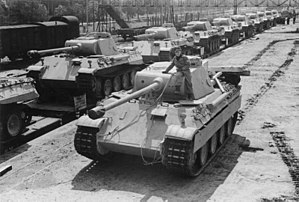Panther tank
| Panther | |
|---|---|

Panther Ausf. D tanks, 1943. The D model can best be recognized by the drum-shaped cupola.
|
|
| Type | Medium tank |
| Place of origin | Nazi Germany |
| Service history | |
| In service |
|
| Used by | Nazi Germany |
| Wars | World War II |
| Production history | |
| Designer | MAN AG |
| Designed | 1942 |
| Manufacturer | MAN, Daimler-Benz, MNH |
| Unit cost | 117,100 Reichmarks |
| Produced | 1943–1945 (1946- 9 postwar for the British Army) |
| Number built | about 6,000 |
| Variants | Ausf. D, Ausf. A, Ausf. G, Befehlspanzer (command tank), Beobachtungspanzer (artillery observer vehicle), Bergepanther (armoured recovery vehicle) |
| Specifications | |
| Weight | 44.8 tonnes (44.1 long tons; 49.4 short tons) |
| Length | 6.87 m (22 ft 6 in) 8.66 metres (28 ft 5 in) gun forward |
| Width | 3.27 m (10 ft 9 in) 3.42 m (11 ft 3 in) with skirts |
| Height | 2.99 m (9 ft 10 in) |
| Crew | 5 (driver, radio-operator/hull machine gunner, commander, gunner, loader) |
|
|
|
| Armour |
Front: |
|
Main
armament |
|
|
Secondary
armament |
|
| Engine | V-12 petrol Maybach HL230 P30 700 PS (690 hp, 515 kW) |
| Power/weight | 15.39 PS (11.5 kW)/tonne (13.77 hp/ton) |
| Transmission | ZF AK 7-200. 7 forward 1 reverse |
| Suspension | double torsion bar, interleaved road wheels |
| Fuel capacity | 720 litres (160 imp gal; 190 US gal) |
|
Operational
range |
250 km (160 mi) |
| Speed | 55 km/h (34 mph) (first models), 46 km/h (29 mph) (later models) |
Front:
80 mm at 55°
LOS thickness: 140 mm (5.5 in)
The Panther was a German medium tank deployed during World War II on the Eastern and Western Fronts in Europe from mid-1943 to its end in 1945. It had the ordnance inventory designation of Sd.Kfz. 171. Until 27 February 1944, it was designated as the Panzerkampfwagen V Panther when Hitler ordered that the Roman numeral "V" be deleted. Contemporary English language reports sometimes refer to it as the Mark V.
The Panther was intended to counter the Soviet T-34 and to replace the Panzer III and Panzer IV. Nevertheless, it served alongside the Panzer IV and the heavier Tiger I until the end of the war. It is considered one of the best tanks of World War II for its excellent firepower and protection. Its reliability was less impressive.
The Panther was a compromise. While having essentially the same engine as the Tiger I, it had more efficient frontal hull armour, better gun penetration, was lighter and faster, and could traverse rough terrain better than the Tiger I. The trade-off was weaker side armour, which made it vulnerable to flanking fire. The Panther proved to be effective in open country and long range engagements, but did not provide enough high explosive firepower against infantry.
The Panther was far cheaper to produce than the Tiger I, and only slightly more expensive than the Panzer IV. Key elements of the Panther design, such as its armour, transmission, and final drive, were simplifications made to improve production rates and address raw material shortages. The overall design remained somewhat over-engineered. The Panther was rushed into combat at the Battle of Kursk despite numerous unresolved technical problems, leading to high losses due to mechanical failure. Most design flaws were rectified in the German retreat, though the bombing of production plants, increasing shortages of high quality alloys for critical components, shortage of fuel and training space, and the declining quality of crews all impacted the Type's effectiveness.
...
Wikipedia
